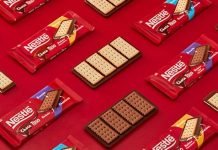Nestlé and Starbucks recently announced the launch of Starbucks creamers, allowing the Starbucks brand to enter the refrigerated creamer category for the first time, which is projected to top US$ 7.8 billion (Rs 53773 crore) by 2023 in the US.
The products were said to be developed by combining Starbucks’ well-loved flavors with Nestlé’s expertise and leadership in the creamer category to give consumers a new way to enjoy their Starbucks coffee at home.
Earlier this year, as a part of the global coffee alliance, Nestlé launched a range of 24 Starbucks products across various platforms. Nestlé and Starbucks claim to drive strong momentum and bring a premium coffee experience to consumers in the grocery aisle and via the Foodservice channels.
David Rennie, head of Beverages Strategic Business Unit, Nestlé SA said, “The global coffee alliance has allowed us to develop and launch new Starbucks products at an unprecedented speed. We are very pleased to expand the Starbucks brand into the creamer’s category less than a year after we closed the deal. We will continue to move fast to deliver great Starbucks coffee experiences to our consumers around the world.”
Starbucks creamers claim to offer a great taste and creamy texture that celebrates the coffee in the finished cup. The creamers will be available in three flavors such as caramel, white chocolate and cinnamon dolce. They are said to be inspired by customer-favorite handcrafted beverages served at Starbucks cafés such as Caramel Macchiato, White Chocolate Mocha and Cinnamon Dolce Latte. According to a press statement, these products will be available in the US groceries stores and at selected online retailers from August.
“We know that Starbucks customers are passionate about their coffee, and with Starbucks creamers, we are delighted to give them another way to enjoy their favorite Starbucks experience and flavors at home and outside our cafes,” said Duncan Moir, president – Global Channel Development at Starbucks.
IndiFoodBev — authentic, impactful and influential
An English-language food and beverage processing and packaging industry B2B platform in print and web, IndiFoodBev is in its third year of publication. It is said that the Indian food and beverage industries represent approximately US$ 900 billion in revenues which implies more than 20% of the country’s GDP. Eliminating the wastage on the farmside can help to deliver more protein to a higher number of the population apart from generating sizable exports. The savings in soil, seeds, water, fertilizer, energy and ultimately food and nutrition could be the most immense contribution that country is poised to make to the moderation of climate change.
To improve your marketing and grow sales to the food and beverage processing and packaging industry, talk to us. Our research and consulting company IppStar [www.ippstar.org] can assess your potential and addressable markets in light of the competition. We can discuss marketing, communication, and sales strategies for market entry and growth.
Suppliers and service providers with a strategy and budget for targeted marketing can discuss using our hybrid print, web, video, and social media channels to create brand recognition linked to market relevance. Our technical writers are ready to meet you and your customers for content.
The second largest producer of fruit and vegetables in the world is continuously expanding processing capacities and delivery systems with appropriate innovative technologies. We cover product and consumer trends, nutrition, processing, research, equipment and packaging from farm to thali. Get our 2025 media kit and recalibrate your role in this dynamic market. Enhance your visibility and relevance to existing markets and turn potential customers into conversations. Ask for a sample copy of our bi-monthly in print or our weekly IndiFoodBev eZine each Wednesday.
For editorial info@ippgroup.in — for advertisement ads1@ippgroup.in and for subscriptions subscription@ippgroup.in
Naresh Khanna – 10 February 2025
Subscribe Now












Why is the packaging looking like it is made of plastic? When dairy and cream products have traditionally been sold in cartons including gable top cartons, is it not possible to carry out this kind of brand extension without using plastic packaging?